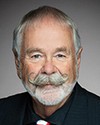To elaborate a bit on your question on how we go about establishing marine protected areas, in Sue's opening remarks she referred to broad policy frameworks that were established. For marine protected areas, that was in 2011, where the Canadian council of fisheries and aquaculture ministers approved the MPA network policy.
The work we've been doing in marine bioregions over the past five years has been based on that framework. It has involved provincial governments, territorial governments, as well as indigenous groups, and marine industries, including the fishing community, oil and gas, and the transport sector.
We have sometimes been accused of taking too long because our consultations are quite lengthy. It's a bit surprising to hear that people think we don't consult enough. In fact, we've been accused of the opposite as well.
The main point is, as Philippe said, it is extensive, in the sense that we need to consult in terms of identifying the conservation objectives for a marine protected area. Beyond that, once they are established, there is a management aspect, a planning aspect, to our approach, which involves identifying which human activities are compatible with the conservation objectives and which ones are not.
In those circumstances, it also involves a great deal of interaction with marine industries and the users of the oceans. That is how we go about this.
The network approach is one that is very useful, in the sense that it allows us to integrate the different tools that the departments here today have at their disposal through different legislative authorities. It also allows us to link sites ecologically, so that we actually are achieving a biodiversity outcome while using the appropriate tool for the conservation objectives that were identified network-wide and not just on a site-by-site basis.




